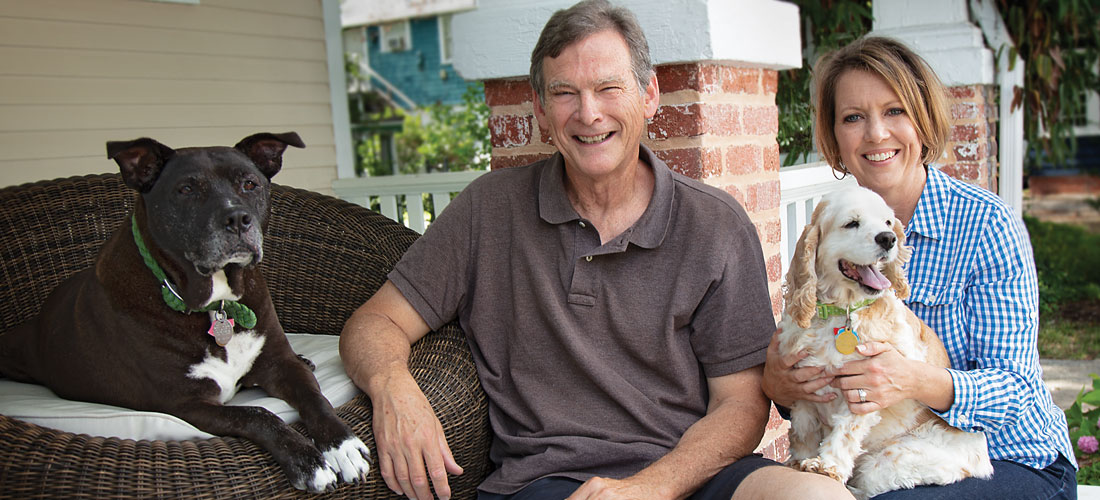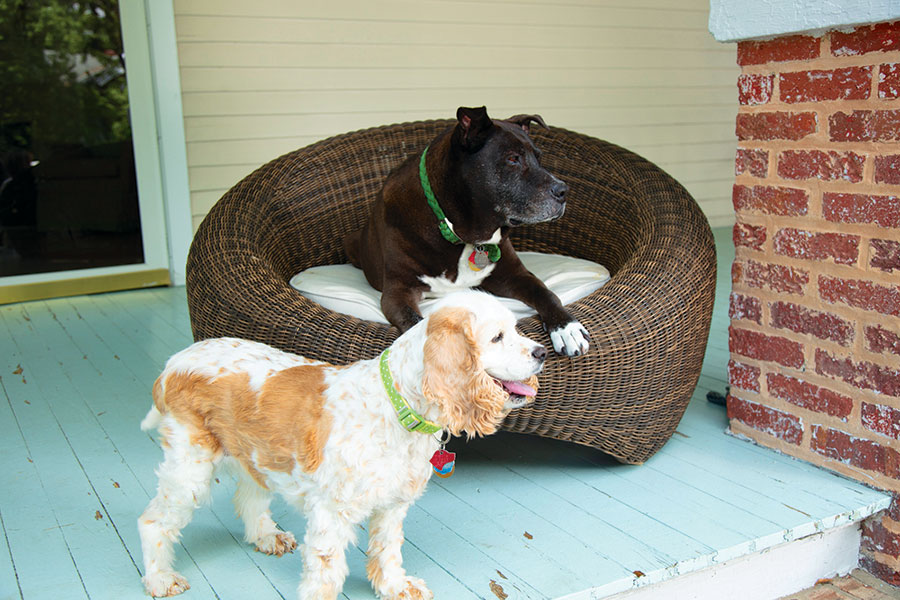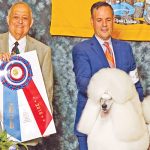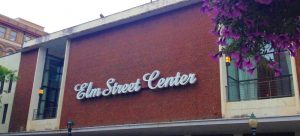
Rescue Me
Lessons of fostering dogs in need of a home
By Ross Howell Jr. • Photographs by Mark Wagoner
The sisters — Laurel and Claire Holland — are teenagers now, but back when my wife, Mary Leigh, and I agreed to foster a dog for two weeks named “Fisher Park Sam” for two weeks, they were girls.
On the evening I rounded the corner of Isabel Street with the new foster — a big brown inscrutable pit-bull mix — the two girls were playing in their front yard. Laurel — the older and taller one — is chatty, and trotted from the yard to the sidewalk at our approach.
“How old’s your dog?” she asked.
“We don’t know,” I answered, pulling Fisher Park Sam to a stop. “The vet thinks maybe he’s 5.”
By then Claire, the younger sister, had joined us on the sidewalk. Claire’s the quieter of the two, more pensive. The dog stood about as high as her chin. She studied him carefully.
Laurel — not especially satisfied with my first response — asked another question.
“What kinda dog is he?”
“We don’t know that, either,” I answered. “He’s a rescue dog.”
Claire was pondering this answer with great gravity.
Then her face brightened. She looked up, placing a hand on her hip.
“Well,” she said. “Has he rescued anybody yet?”
Fisher Park Sam was our second try at fostering a rescue.
The first had come and gone not long before — a young male dog named Patches.
There are breed-specific rescue organizations networking throughout the country, and Patches came to us through an English cocker spaniel rescue group. His owner in Durham had become nearly immobile from the onset of a progressive illness, and could no longer provide the dog’s care.
Patches was handsome, remarkably like a dog I’d owned years before. He was bright, eager, well-behaved and neutered. He had everything going for him — the kind of foster that quickly finds a permanent home.
And he did. In a matter of days.
A work colleague of mine and his partner wanted him. Mary Leigh and I knew they’d provide a wonderful home.
But I’d let myself grow so attached to Patches I couldn’t even be at our house the evening he was picked up. I left Mary Leigh in charge of the transfer, and drove around Greensboro for an hour, sobbing like a boy.
It was a hard lesson. If you don’t give up a foster dog, then you can’t help another.
Enter Fisher Park Sam.

I’d seen him collarless a couple of evenings in the dead cold of February as I walked our full-time English cocker, Pinot, in Fisher Park. He’d wag his tail and sniff Pinot, but whenever I tried to put a hand on him, he’d vanish into the night.
We learned a neighbor had brought him in off the streets that spring. He was gaunt, just half the body weight he carries today. He had heartworms. He was intact, so he’d have to be neutered.
Another neighbor, Sally Atwood, along with others, had started a fund in the name of “Fisher Park Sam” at North Elm Animal Hospital. Dr. Anne Mitchell was providing his care.
“Any veterinarian is going to help with stray or homeless pets,” says Mitchell. “While Sam had a fund, vets also provide pro bono services when they can.”
What brought Mary Leigh and me into Fisher Park Sam’s life was a more immediate problem. The neighbor who’d rescued him in the spring lived in a small apartment and had a large dog of his own. It was just too much to manage.
So we agreed to foster him for two weeks, so other arrangements could be made. Frankly, we were concerned about bringing a big, strange dog into the house with our 25-pound cocker.
Fisher Park Sam was scary. Silent. His eyes were blank from pain and sickness. There were broad scars on his muzzle, neck and shoulders. His coat was thin and dull. Sometimes when I walked him I’d see people cross the street ahead so they wouldn’t have to pass him on the sidewalk.
He was inscrutable as Buddha. But — we discovered — just as wise.
Nothing bothered him. Not Pinot lording it over him in her small dog diva way, jealously guarding her toys, scrambling into his bed from her own just as he was about to lie down. He’d raise his head and look at me in silence, waiting for me to correct the situation. I’d put Pinot in her bed and he’d curl up in his own.
No one would adopt him, as is the case for many dark-colored dogs.
So we adopted Sam, and he began his new life as nanny dog.
We received another call from the English cocker rescue. This was for an older dog named Buddy that had been abandoned by his family. They’d just packed up their house and moved, leaving him on the spot. We were told he had digestive issues.
When we picked him up in Hickory, his stomach was badly bloated. He was so depressed and sick he wouldn’t make eye contact. He had given up.
On the trip from Hickory he farted so often and with so much fragrance we had to keep the car windows rolled down in spite of the heat. None of this bothered Sam, his backseat companion for the trip.
In time we got Buddy relatively healthy. He turned out to be a clown, doing what we called his “happy dance” whenever it was mealtime. In spite of his fear of cameras, we were able to get some pictures.
Buddy hit the adoption lottery. He was nearly the twin of a dog a man and wife living in southern Ohio had recently lost to old age.
Mary Leigh and I were misty-eyed as Buddy climbed into the couple’s van, already outfitted with a plush new dog bed and plenty of treats and water. They sent us photos periodically of his final years napping at home in his personal leather recliner or in his bed at his owner’s office.
Next was Cher, a red miniature dachshund rescued with her brother Sonny from a puppy mill in South Carolina. Her brother was so ill he died. But Cher was about as full of life and attitude as a dog gets.
She immediately fixed on Sam. Wherever he might venture, Cher was sure to follow. This was especially helpful in training her to walk on lead. As far as we could tell, she had never been out of a cage. The first time I put her on the sidewalk, she face planted when she stepped off the curb.
She could chew through a harness more quickly than Houdini could pick a lock, escaping from Sam and me three times. And she ate a portion of the back seat of my old Volvo while I was in the bank depositing a check. While Sam watched, of course.
But Cher found a home with a dachshund-lover outside Philadelphia, an elderly lady who already had dachshunds at home and wanted another.
Through Cher we learned about a kind of Underground Railroad for dogs — a system of vehicles driven by volunteers who ferry animals place-to-place. Some volunteers spend their whole weekends in this service.
We drove Cher to a Holiday Inn just north of the Virginia line on I-85. From there she was driven to Arlington, Virginia. There she changed cars for Baltimore. Finally, with a different driver, she was delivered to Philly.
Next we fostered Sansa, a magnificent, honey-colored female pit-bull mix with white markings and pale green eyes. She was remarkably intelligent, but so headstrong and full of energy she was tossed out of obedience classes twice. I was never able to get her to walk without tugging. Sam and I were never fitter, walking mile upon mile to try to wear her down.
Sansa found a home in New Hampshire with a woman who had a police officer friend who trained canines. Sansa’s new owner made the 11-hour drive each way to Greensboro over a weekend with a friend. When last we heard, Sansa was an inseparable companion to the woman’s cats, a vigilant guard against neighborhood black bears, and the absolute star of her obedience school.
Next came Sophie, a brindle 8-week-old pit bull we kept for a weekend. She completely terrorized Sam during her brief stay. He ran from her on every occasion, inside the house or out. It was clear Sam didn’t do puppies.
Then there was Elly Mae, a blue pit bull with white markings. She believed sandy beaches had been created just for her. She dug holes. She dug canals. She dug so deep she’d lie sideways in the hole and dig laterally. She dug until she’d nearly covered Sam with sand as he sat stoically by, watching pelicans ride the wind.
Next was Greta, a white propane tank of a dog, with big, ink-black spots here and there. As with Sam, we’d agreed to foster her for two weeks. But her circumstances were quite different.
Greta had already found her forever home, if we could help her recover from a snakebite just under her right eye. That side of her face was a grotesque mask, swollen half again as large as the left side, with a thick scab about the size of a silver dollar on her cheek.
Sweet and stalwart, young Greta was good about her medications and recovered quickly. Though she’ll always have a scar from the abscess on her cheek, the swelling in her face had nearly disappeared when she left us for her new life.
And last there’s Lucy, a nearly deaf 10-year-old American cocker. She looks like Lady in the Disney movie, Lady and the Tramp. Only she has more spots.
Lucy came to us by way of fellow writer Maria Johnson, who — along with other neighbors — had been providing food and care for her after her owner essentially abandoned her.
Lucy follows me everywhere. Sometimes when I’m working outside she puts her little paws up in a window and gazes longingly. You’d think I’m the scientist who’ll one day discover the cure for cancer or the diplomat who’ll formalize the agreement for a de-nuclearized Korean Peninsula.
Most of us have had our share of disappointment and loss. Maybe that’s why I like working with dogs, dogs whose options have nearly run out, whose prospects are anything but bright, dogs who’ve forgotten what kindness is if they’ve ever known kindness at all.
It’s not easy to help dogs. Sometimes you fail. And sometimes there’s Sam. His two-week stay has stretched to seven years.
I’ve written essays about him. I’ve used him as the inspiration for a character in a novel.
When years ago my little neighbor Claire asked me if Sam had rescued anybody, I didn’t have an answer. Now I do.
Sam was rescuing me. OH
Ross Howell Jr. and Sam are enjoying their walks with Lucy. Given their ages, they don’t walk very far. And not very fast.
In case you’re interested in helping dogs or other animals, here are some local groups you may not have heard about:
All Pets Considered manager Alison Schwartz is the Greensboro contact for the Almost Home Dachshund Rescue Society, a nationwide organization of volunteers that seeks to rescue abandoned, abused, neglected and unwanted dachsunds and dachshund mixes, provide necessary veterinary and behavioral care for them, and place them in homes where they will be a perfect fit. Info: allpetsconsidered.com.
The Animal Adoption and Rescue Foundation (AARF) was organized in 1995 as a not-for-profit 501(c)(3) organization to provide safe, loving, and appropriate homes for homeless cats and dogs. With its house at 311 Harvey St. in Winston-Salem, AARF is supported by a volunteer board of directors and dozens of volunteers who work tirelessly to implement the mission of the organization. Info: aarfanimals.org.
The heart of the Merit Pit Bull Foundation is the rescue, fostering, and permanent placement of pit bull type dogs abandoned, neglected, abused, or surrendered by their owners in North Carolina. The foundation promotes education about the breed to the general public, media, and lawmakers; teaches responsible dog ownership; and supports community action for the benefit and welfare of pit bull type dogs. Info: meritpitbullfoundation.com
With two employees and dedicated foster families and volunteers in Guilford, Forsyth, and Rockingham counties, the Red Dog Farm Animal Rescue Network is a 501(c)(3) public charity providing rehabilitation, fostering, and adoption for animals of all sizes. Offices are located at 5803 Bur Mil Club Road. Over the years Red Dog Farm has helped more than 1,700 animals find forever homes. Info: reddogfarm.com.
Triad Golden Retriever Rescue, Inc. (TGRR) is a 501(c)(3) non-profit, volunteer organization dedicated to the rescue, rehabilitation, humane treatment, and placement of homeless golden retrievers, and to the education of the public about the breed. Foster homes are always needed. TGRR works with other regional rescue groups to arrange long-distance adoptions when necessary. Info: www.tgrr.
The Humane Society of the Piedmont, located in Greensboro, was founded in 1953. A non-profit organization dedicated to reducing pet-overpopulation, its largest program is the Planned Pethood Spay, Neuter and Wellness Clinic. The society also offers a SPOT Mobile Clinic, as well as FURRY FRIENDS financial assistance to owners who need help providing food or veterinary care for their pets. Info: hspiedmont.org
The SPCA of the Triad has been caring for neglected, abandoned, and injured animals for 22 years. Currently located at 3163 Hines Chapel Road, the SPCA is currently raising money to build a new, larger facility. By providing shelter, food, medical services, spay and neuter, safety, caring, and adoption services, SPCA staff and volunteers help transform frightened animals into trusting, loving companions. Info: spca.org.





